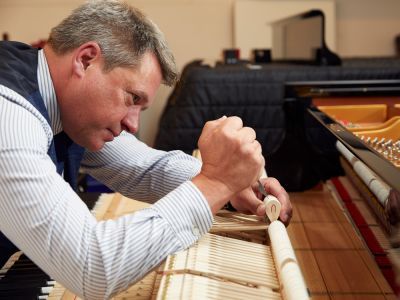Behind the Scenes: Tuning In

A piano is as sensitive a musical instrument as a violin. It’s also a mechanical wonder with over 5,000 serviceable parts. When I teach the piano students about the history and development of the structure at the start of their studies, a lot of them have never thought about the piano in this way. They think about the keyboard layout and the music, but not about the fact that they’re controlling a set of felt-covered hammers that are key-activated. That’s the part of the instrument I see and hear – and the bit I have to work on.
For example, in Formula 1 you can have a fantastic car, but if it’s not maintained properly it becomes unreliable; and if it’s not set up to perfection, you’re going to lose speed. My job is to make sure the 88 notes on all the pianos have the very best tonal response and accurate feel of balance weight, and that nothing else is out of kilter. I’ve got to recognise special characteristics and sense what the pianos are telling me. When I’m tuning one, I listen to the wood as much as I do the strings to find out if it is happy or stable, or about to shift in any way.
I studied piano technology at the London College of Furniture, but I don’t think they ever mentioned that piano tuning usually means an early start, every day, before 7am! At Guildhall, all the performance instruments to be used that day have to be set up. That’s up to 12, including in the theatres. I’ll regularly have to attend to seven or eight of them before 10am. That means if there’s a special performance, I’ll do a thorough tuning and prep, which takes anywhere from three to eight hours in the days before, so that on the day I only need to do any final tweaks.
The performance pianos have to be kept at a world-class standard at all times. Then there are the professors’ pianos. Timewise, it’s not possible to set these up to the same level as the performance ones, but I can set them up to a very high level in recesses and keep them there for the term. And then there are the practice instruments. Every single piano in Guildhall is played constantly, seven days a week. My work is rather like a performance of spinning plates: the first row has to be perfect, you get to the second as soon as you can, and by the back row, if a few fall off, hopefully nobody’s watching!
Every student does their exam on a performance piano, and I am passionate about getting that set up to as high a standard as for any of the visiting artists. I’m aware that my work has a huge impact on how they may do in their exam. That’s a huge responsibility.
With major visiting performers, I tailor my work to the individual performance, towards both the programme and the artist. I wouldn’t ask them to play on a piano that had performed very different music very recently. It’s not just the strings, it’s the whole body of the piano. The wood remembers the vibrations – it takes a day or so to recover for something new. And then earlier music may suit a much narrower tuning stretch, whereas more contemporary music may take a much wider one. You work with what you think the pianist needs – more attack, or a brighter sound, or a sound that’s much more colourful in the mid-range.
You can completely change the way in which that combination of notes is going to bloom. However, too much in any direction may not be possible to restore for someone else.
Once I am happy with what I’ve prepared, then that’s the foundation to discuss with the performer and filter in the practicalities. The piano tuner is often the last person that a pianist or exam student will talk to before a concert. You want to work with what they ask for, but it’s essential to work out why they’re asking it. Do they want a faster repetition because the piano is slow or their fingers aren’t working as quickly as they were last week? Are they jet-lagged or coming down with a cold or nervous? You have to be very attuned not only to the instrument but also to the pianist’s body language and world. The only way you can do that is to set up the piano in advance to the best possible standard, so that you can then think about what they are asking, and whether that is feasible and how it will balance out. Your mind is constantly assessing the whole situation, within a very tight timeframe, to come to a decision that you – and they – will have to live with.
And then each performer will come along and make the piano sound like their own. I never fail to find that intriguing. You rarely get thanked for it up on stage, but walking home after an amazing performance that you helped made possible is a great feeling.
This article first featured in the Autumn/Winter 2018 edition of the Guildhall magazine, PLAY, and was written by YBM for the Guildhall School.